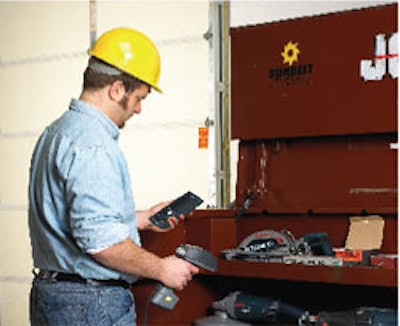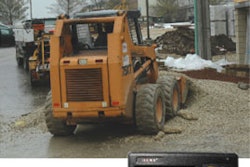
Replacing lost and stolen tools quickly adds unnecessary cost to your projects. Without a tracking system, it is almost impossible to keep track of where your tools are and even if they are still in your possession. Workers may hoard tools in their pickups or not even realize if a tool has been stolen from the vehicle. You may actually end up purchasing tools you already own, but can't find, just to get the job done.
"One of the reasons tools get lost or walk off is that people have difficulty identifying tools uniquely after they have started to get into the construction environment," says John Doherty, product manager for Safe & Sound, Bosch Digital Tools. The company claims that tool retention on individual jobsites rises up to 96% when employees are held accountable for their tools with a tool tracking system.
Many of the larger companies try to track hand tools through a variety of systems. The most basic is simply writing down the serial number of the tools and where they are on a piece of paper. But when there are several units, this can be a difficult way to track the tools.
Software tracking and bar codes provide a better solution. "Bar coding has been in the marketplace for some time and it is very efficient," says Doherty. "That was the first huge savings over paper."
But bar coding presents its own challenges. The bar codes can come off or be scratched by the everyday working conditions on the jobsite. In some cases, you may have to correlate the bar code to a catalogue to identify the particular tool.
A Safe & Sound Solution
"Our customers were asking for a better and more robust way to track tools," says Doherty. So the company developed Safe & Sound, which uses Radio Frequency Identification (RFID) technology.
"RFID is the next step," says Doherty. "It eliminates the issue of having to re-read the bar code or re--apply a new label. Also, the RFID tag has more information on it. A bar code is a series of digits. What we have done with the RFID tag is put in the model number and serial number of that individual tool so someone does not have to either key it in or correlate it to a physical catalogue. They have that information directly on the RFID tag."
These tags are inserted inside the tool, where they are protected from the elements and tampering. "If you see a tool tagged with an internal electronic sensor, you know that there is no way to disable it, short of dismantling the tool and finding the very small RFID tag," says Doherty. "They are 1" x 1/4" by paper thin."
The chips Bosch currently uses are passive in nature. "RFID tags are essentially chips with antennas attached to them," says Doherty. "A radio signal from a reader device activates the tag, which then broadcasts the information back to the reader. There are quite a few readers on the market which can read passive RFID tags. In the case of Safe & Sound, the tag provides basic information such as the tool's model and unique serial number."
But the RFID tag is only part of the Safe & Sound offering. Participants in the program get two tags. "The first tag is the RFID tag," says Doherty. "The other tag, which we also insert, is an Electronic Article Surveillance (EAS) tag. Bosch provides the tag as a free addition to make a complete tracking set."
This tag can be sensed by security portals placed at the entry and exit points to the jobsite or tool crib, similar to a retail environment. "If you walk through the portal [with the tool] the alarm goes off," says Doherty.
The RFID tags are compatible with most tool tracking software and Safe and Sound is available with 70 skews of Bosch's existing tool family. The tool comes with an RFID tag, inserted somewhere within the tool, which has the serial number and model number on it.
Safe & Sound also covers other makes and models of tools. "For those companies that have a pre-existing tool inventory both from Bosch and other manufacturers, we offer the ability to buy tags from us which will have that same information," says Doherty. "So they can insert them into their pre--existing tools."
The objective is that this is not just Bosch's proprietary RFID tag. "We have an existing customer who is using this where a third of the tools were Bosch and another two-thirds were non-Bosch manufactured tools," says Doherty. "We supplied tags for all of their tools. So Bosch provides the individual aftermarket tags, as well as the new tools with the tags in them".
"Similarly, we are gladly providing the format of our tags to any of the tool tracking applications," Doherty adds. "We started initially with a company called ToolWatch because we had a working relationship with them on several different fronts. They adjusted their software to read our RFID tags."
The goal is to gain better control over your tool and equipment investment. There is a huge cost--saving potential by preventing theft and knowing where your tools are so you don't have to rent or purchase what you already own.



















